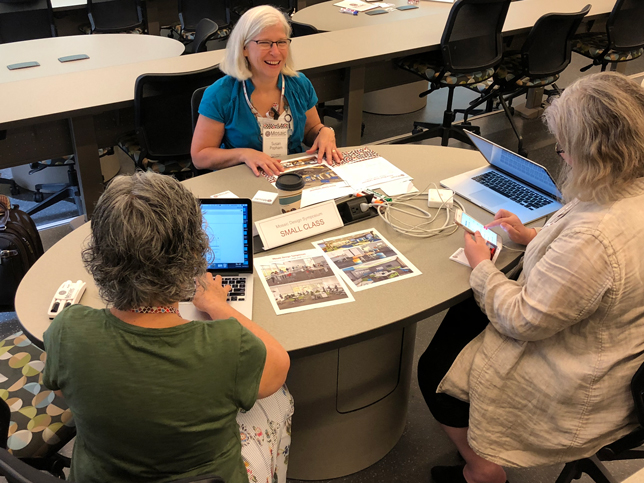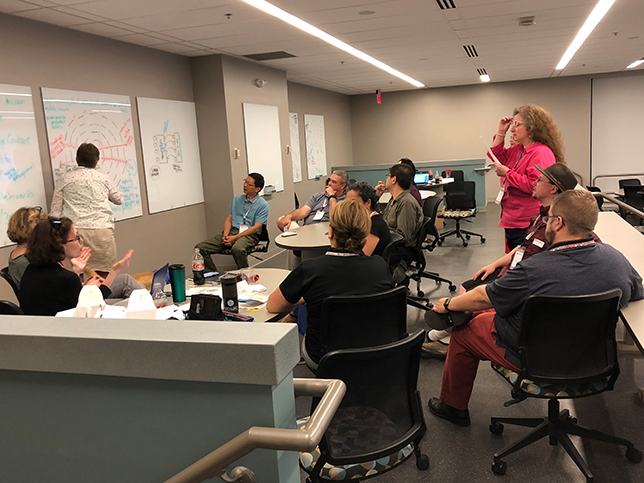When Faculty Design Classrooms of the Future
At Indiana University, faculty input is a key part of the classroom design process. Here's how a recent symposium fostered cross-campus collaboration and future-thinking conversation about new learning spaces.
- By Tracey Birdwell, Ph.D., Julie Johnston
- 08/01/18
Indiana University's Mosaic Initiative, a program that supports innovative learning space design, research, and comprehensive support across the institution, regularly brings faculty voices to the design process when creating our active learning classrooms. To give those conversations a formal home, Mosaic recently held the inaugural Mosaic Design Symposium, a day of workshops and brainstorming about the future of IU's learning spaces.
The event, produced in partnership with the university's Learning Spaces team, convened 21 Mosaic fellows from across IU's seven campuses to design classrooms of the future. The Mosaic fellows, who spend an academic year teaching in and exploring other active learning classrooms, were an ideal group to engage in a future-thinking conversation about space.
The symposium was structured to maximize creative thinking, collaboration and sharing. Prior to the event, each fellow was asked to choose a traditional learning space to reimagine: a large lecture hall, a medium-sized classroom, a small classroom or a computer lab (most fellows chose the type of classroom in which they most often teach). The participants' self-sorting created multi-disciplinary "design teams" that included fellows from different IU campuses. Providing this opportunity for cross-discipline as well as cross-campus collaboration was a major goal of the symposium.

The symposium began with participants viewing "inspiring images" of classroom design as to encourage their own ideas. (Photo courtesy of Indiana University)
On the day of the symposium, each design group received inspiration images of the classroom of their assigned type. Then, each group was asked to create their own classroom with a design prompt that encouraged participants to "think differently and think big" about their classroom design. Over the course of 90 minutes, the groups were asked to brainstorm and then both sketch their ideas on glass boards and capture their ideas in a shared Google doc. In that way, their work could be shared with multiple stakeholders.
After lunch, the groups each presented their own designs and engaged in conversation about their ideas. Members of the Learning Spaces team were on hand to listen to the faculty discussions about the future of spaces at IU. As Larry Darling, principal learning spaces engineer, noted, "This event presented a unique opportunity to observe the design process, as end users planned their ideal teaching environments. This type of access challenged my paradigm of what defines a successful learning space. As I move forward, I will be able to share this refinement with other members on my team as we implement future classrooms."

The fellows share their final classroom designs with another design group. (Photo courtesy of Indiana University)
In order to share the designs with the many stakeholders across IU that could not be present, we created a Symposium Summary report to gather the faculty's designs and design concepts. A number of common themes appeared across the groups' designs:
- Spaces that encourage interaction. Most of the designs focused on encouraging interactions within student groups, among student groups, with instructors, and with student-generated work on whiteboards and monitors.
- Access to students. Faculty in all of the space design groups wanted easy access to students. They desired the ability to move around the room as well as the ability to view all students wherever they were in the classrooms.
- Easy-to-use technology. Faculty designed rooms with technology that was consistent, user-friendly, flexible, mobile (if they wanted to move something out of the way for a class meeting), and that fostered student content sharing and collaboration.